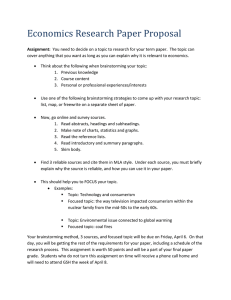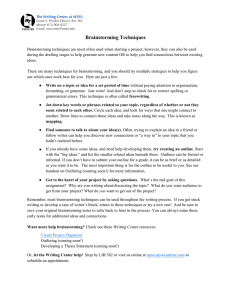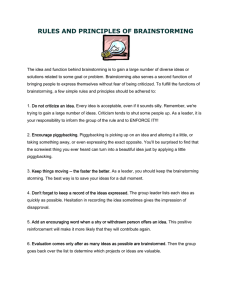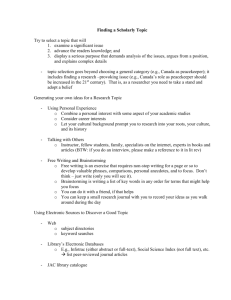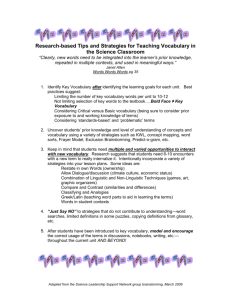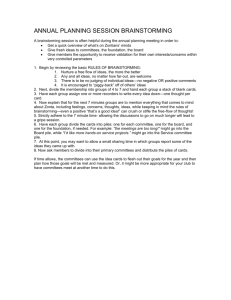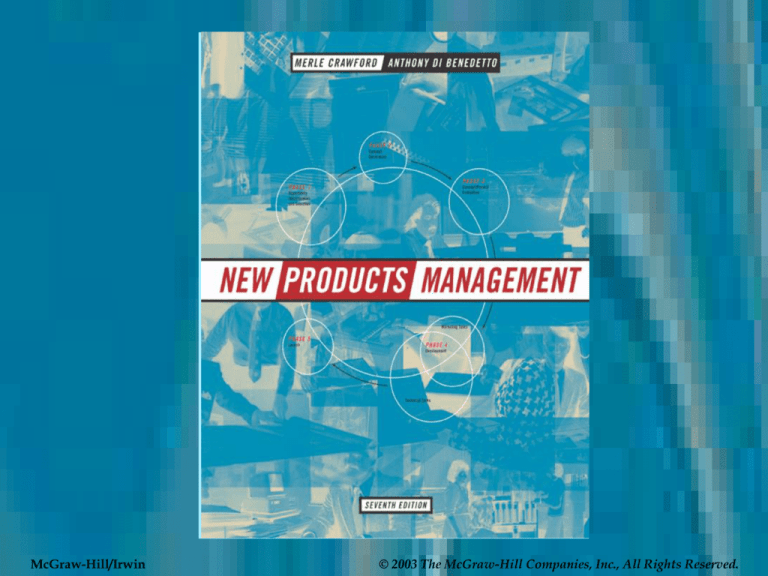
15-1
McGraw-Hill/Irwin
© 2003 The McGraw-Hill Companies, Inc., All Rights Reserved.
25-2
CHAPTER FIVE
PROBLEM-BASED
IDEATION
35-3
Problem-Based Concept Generation
Figure 5.1
45-4
Developing Successful New Product Ideas
Figure 5.2
Two key dimensions for winning new product
ideas:
Utility lever: How the product will affect the
customer’s life (such as simplicity, fun/image,
environmental friendliness, reduced risk,
convenience, and productivity).
Buyer’s experience cycle: The stage when/where
the product will affect the customer (purchase,
delivery, use, supplements, maintenance, disposal).
55-5
Problem Analysis: General Procedure
1. Determine product or activity category
for study.
2. Identify heavy users.
3. Gather set of problems associated with
product category.
– Avoid “omniscient proximity” -- rate
importance of benefits and levels of
satisfaction.
4. Sort and rank the problems according to
severity or importance.
65-6
Problem Analysis Applied to the Telephone
Figure 5.3
•
•
•
•
•
•
•
•
•
•
Keeping the unit clean.
Keeps falling to the floor.
Get entangled with cord.
Finding it in dark.
Getting privacy in house.
Who “out there” hears me?
Get past message phones.
Looking up numbers.
Busy signals.
Hard to hold.
• Move across rooms or
buildings.
• Phone peddlers.
• My arm and ear get tired.
• Loudness of bell.
• Disruptive instrument.
• Can’t see body language.
• Making emergency calls.
• Wrong numbers.
• Fear of what ringing is for.
• Those “menus.”
75-7
The Bothersomeness Technique
List of pet owners' problems:
Need constant feeding
Get fleas
Shed hairs
Make noise
Have unwanted babies
A
Problem Occurs
Frequently
98%
78
70
66
44
B
Problem is
Bothersome
21%
53
46
25
48
Figure 5.4
AxB
.21
.41
.32
.17
.21
85-8
Problem Analysis: Sources and
Methodologies
• Experts
• Published Sources
• Contacts with Your Business Customers or
Consumers
–
–
–
–
Interviewing
Focus groups
Observation of product in use
Role playing
95-9
Scenario Analysis
• “Extending” vs. “leaping”
• Using seed trends for an “extend“ scenario
• Techniques:
–
–
–
–
Follow “trend people”/”trend areas”
“Hot products”
Prediction of technological changeover
Cross-impact analysis
5-10
10
Relevance Tree Form of Dynamic Leap
Scenario
Figure 5.5
5-11
11
Wild Card Events and
Their Consequences
Figure 5.7
• No-Carbon Policy: Global warming may cause governments to put
high taxes on fossil fuels, shifting demand to alternative sources of
energy. This changes the allocation of R&D investment toward
alternative energy, possibly causes new “energy-rich” nations to
emerge, and ultimately may lead to a cleaner environment for
everyone.
• Altruism Outbreak: This is the “random acts of kindness” movement
– solve social problems rather than leaving it up to the government.
Schools and other institutions will revive due to community actions,
and perhaps inner cities would be revitalized.
• Cold Fusion: If a developing country perfects free energy, it becomes
prosperous overnight. It gains further advantages by becoming an
energy exporter.
5-12
12
Solving the Problem
• Group Creativity Methods/Brainstorming
• Principles of Brainstorming:
– Deferral of Judgment
– Quantity Breeds Quality
• Rules for a Brainstorming Session:
–
–
–
–
No criticism allowed.
Freewheeling -- the wilder the better.
Nothing should slow the session down.
Combination and improvement of ideas.
5-13
13
Brainstorming Techniques
•
•
•
•
•
Brainstorming circle
Reverse brainstorming
Tear-down
Phillips 66 groups (buzz groups)
Delphi method


